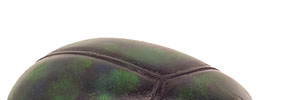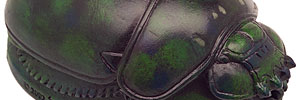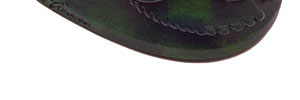In ancient Egypt, several species of the dung beetle, most notably the Scarabaeus sacer (often referred to as the "sacred scarab"), enjoyed a sacred status. The heiroglyphic image of the beetle represents a trilateral phonetic that Egyptologists translate as "to come into being", "to become", or "to transform".
Excavations of ancient Egyptian archaeological sites have uncovered images of the scarab created from stone, ivory, bone, precious metals, and Egyptian faience, dating from the Sixth Dynasty and up to the period of Roman rule. The scarabs are generally small, bored to allow stringing on jewelry, and bearing a brief inscription or cartouche on the base. Some have been used as seals. Pharaohs would occasionally commission the manufacture of larger images with detailed inscriptions, such as the commemorative scarab of Queen Tiye. Massive sculptures of scarabs can be seen at various locations in Egypt, such as at Luxor Temple, and at the Serapeum in Alexandria.
Cold Cast is a modern method of casting sculptures using a mixture of resin and powdered polymer materials. The finished sculpture has a surface which looks very similar to traditionally cast material, but tends to be much lighter.














